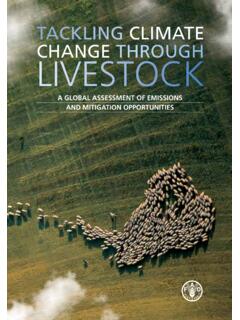Transcription of Greenhouse gas emissions from pig and chicken supply ...
1 A global life cycle assessment Greenhouse gas emissions from pig and chicken supply chainsA report prepared by:FOOD AND AGRICULTURE ORGANIZATION OF THE UNITED NATIONSA nimal Production and Health DivisionA global life cycle assessment Greenhouse gas emissions from pig and chicken supply chainsRecommended CitationMacLeod, M., Gerber, P., Mottet, A., Tempio, G., Falcucci, A., Opio, C., Vellinga, T., Henderson, B. & Steinfeld, H. 2013. Greenhouse gas emissions from pig and chicken supply chains A global life cycle assessment. Food and Agriculture Organization of the United Nations (FAO), designations employed and the presentation of material in this information product do not imply the expression of any opinion whatsoever on the part of the Food and Agriculture Organization of the United Nations (FAO) concerning the legal or development status of any country, territory, city or area or of its authorities, or concerning the delimitation of its frontiers or boundaries.
2 The mention of speci c companies or products of manufacturers, whether or not these have been patented, does not imply that these have been endorsed or recommended by FAO in preference to others of a similar nature that are not views expressed in this information product are those of the author(s) and do not necessarily re ect the views or policies of 978-92-5-107944-7 (PDF) FAO 2013 FAO encourages the use, reproduction and dissemination of material in this information product. Except where otherwise indicated, material may be copied, downloaded and printed for private study, research and teaching purposes, or for use in non-commercial products or services, provided that appropriate acknowledgement of FAO as the source and copyright holder is given and that FAO s endorsement of users views, products or services is not implied in any requests for translation and adaptation rights.
3 And for resale and other commercial use rights should be made via or addressed to information products are available on the FAO website ( ) and can be purchased through gas emissions from pig and chicken supply chainsA global life cycle assessmentThis report presents results from an assessment carried out to improve the under-standing of Greenhouse gas (GHG) emissions along livestock supply chains. The analysis was conducted at the Animal Production and Health Division (AGA) of FAO and co-financed by the Mitigation of Climate Change in Agriculture (MICCA) programme.
4 The following persons and institutions contributed to this undertaking:Study team: Pierre Gerber (Team leader, FAO) Michael MacLeod (Principal investigator, FAO) Theun Vellinga (Livestock modeler, Wageningen University) Alessandra Falcucci and Giuseppe Tempio (GIS modelling, FAO) Benjamin Henderson, Klaas Dietze, Guya Gianni, Anne Mottet, Carolyn Opio, Tim Robinson, Olaf Thieme and Viola Weiler (data collection and analysis, FAO)The followings provided comments, views and information that contributed to the analysis.
5 Alexandra de Athayde (International Feed Industry Federation) Imke de Boer (Wageningen University) Peter Bradnock (International Poultry Council) Christel Cederberg (SIK and Chalmers University of Technology, Gothenburg) Jeroen Dijkman (FAO) Vincent Gitz (FAO) Vincent Guyonnet (International Egg Commission) Mario Herrero (Commonwealth Scientific and Industrial Research Organ-isation) Dong Hongmin (Chinese Academy of Agricultural Science) Hsin Huang (International Meat Secretariat) Adrian Leip (Joint Research Centre of the European Commission, Ispra, Italy) Brian Lindsay (Sustainable Agriculture Initiative) Alexandre Meybeck (FAO) Nathan Pelletier (Joint Research Centre of the European Commission, Ispra, Italy) Marja Liisa TapioBistrom (FAO, for the MICCA Programme) Greg Thoma (University of Arkansas) Tom Wassenaar (Centre de coop ration internationale en recherche agrono-mique pour le d veloppement)Report writing.
6 Michael MacLeod, Pierre Gerber, Anne Mottet, Giuseppe Tempio, Alessandra Falcucci, Carolyn Opio, Theun Vellinga, Benjamin Henderson and Henning of contentsList of tables viiiList of figures xAbbreviations xiiDefinitions of commonly used terms xiiiExecutive summary xvii1. InTroducTIon Background Scope of this report The Global Livestock Environmental Assessment Model Outline of this report 22.
7 OvervIew of The Global monoGasTrIc secTor 53. meThods Choice of Life Cycle Assessment (LCA) General principles of LCA The use of LCA in this assessment Functional units and system boundary Sources of GHG emissions Overview of calculation method Spatial variation and the use of Geographic Information System Emission factors Land-use change Data sources and management Allocation of emissions between products, by-products and services Production system typology 144. resulTs for pIG supply chaIns Global production and emissions emissions intensity Variation in emission intensity between backyard, intermediate and industrial pig systems Geographical variation in emissions intensity Analysis of uncertainty in pig emission intensity Identification of main emissions categories Selection of parameters for inclusion in the analysis and their ranges Results of the Monte Carlo analysis Comparison of the pig results with other studies Scope Input assumptions Ration 41vi5.
8 ResulTs for chicken supply chaIns Global production and emissions emissions intensity Variation in emission intensity between broiler meat and layer eggs Variation in emission intensity between backyard and commercial systems Geographical variation in emission intensity Analysis of uncertainty for chickens Identification of main emissions categories Selection of parameters for inclusion in the analysis and their ranges Results of the Monte Carlo analysis for chickens Comparison of the chicken results with other studies Scope Ration Soybean and soybean meal LUC Feed N2O Feed CO2 Manure management Allocation Summary 636.
9 Summary of producTIon and emIssIon InTensITIes Commercial systems (layers, broilers, industrial and intermediate pigs) Backyard systems Gaps in emission intensity within systems and regions 677. conclusIons 71references 75appendIces 79 APPENDIx A overvIew of The Global lIvesTock envIronmenTal assessmenT Model (GleAM)
10 85 APPENDIx B daTa and daTa sources 101 APPENDIx C ChAnGes in CArbon stoCks relAted to lAnd use And lAnd-use ChAnGe 123 APPENDIx D posTfarm emissions 143 APPENDIx E emissions relaTed To enerGy use 147viiAPPENDIx F AlloCAtion to slAuGhter bY-produCts 155 APPENDIx G maps 157 APPENDIx H counTry lIsT 169viiilist of tables1. Sources of GHG emissions included and excluded in this assessment 92.










